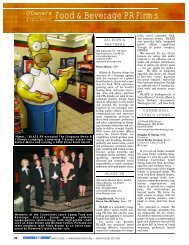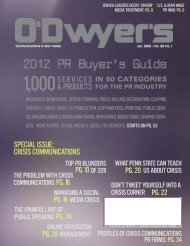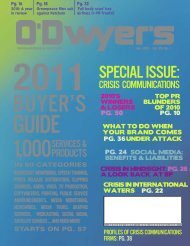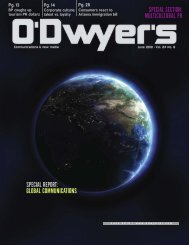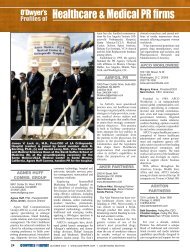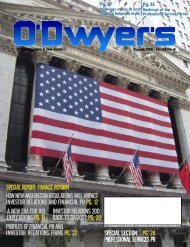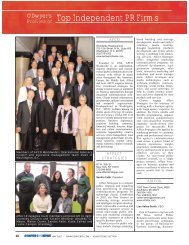INTERNATIONAL & MULTICULTURAL ISSUE - Odwyerpr.com
INTERNATIONAL & MULTICULTURAL ISSUE - Odwyerpr.com
INTERNATIONAL & MULTICULTURAL ISSUE - Odwyerpr.com
Create successful ePaper yourself
Turn your PDF publications into a flip-book with our unique Google optimized e-Paper software.
FEATUREFive subjects they don’t teach in PR schoolBy Shelley SpectorMany years ago, I asked EddieBernays, the father of publicrelations, what he thought wasan ideal undergrad level PR program.Considering this question was askedyears before a PR degree would be widelyconferred at U.S. colleges, Bernays had theopportunity to construe his own ideas foran ideal BA degree in Public Relations.“In today’s world, the best PR degreewould be equally divided among three disciplines:one-third journalism, one-thirdpsychology, and one-third business,”replied Bernays.In short, he was saying that studentsshould learn the tools of the trade throughjournalism: news writing, understanding ofnews and the media. They also shouldlearn the principles of human motivation:an understanding of our publics and howbest to influence their perceptions.And very importantly — and here iswhere Bernays thought our profession wastruly lacking — future PR professionalsshould learn finance and how businessesoperate. By this he didn’t mean just ourclient’s business, but the greater businessworld.Fortunately, a growing number of PRgrad programs, like NYU’s, are now incorporatinginto curriculums courses thatteach students critical skills, like learninghow to read a balance sheet, writing an IRprogram and understanding SEC <strong>com</strong>pliance.But yet few undergrad programs arerequiring this. They should.PR students should also understand thegrowing influences of politics and governmenton the practice of PR. Equally importantfor tomorrow’s practitioner is anappreciation of reaching a global audience.So what does this mean for today’s PRgraduate? What are some of the subjectsmost valued in the PR field but that undergraduatePR students never learn?1. Consumer Behavior. Of all thecourses I took at my college’s businessschool, the one that proved to be the mostpotent to my appreciation of public attitudeswas Consumer Behavior 201 — amix of social psychology, market researchand mass <strong>com</strong>munications. Only throughlearning how to assess customer sentiment,is it possible to influence attitudes andbehavior and eventually build whatBernays’ called a “two way street” of trustbetween an institution and its publics.Malcolm Gladwell’s “Tipping Point”and “Blink” are excellent explorations ofthe topic, as is my old time favorite bookthat first introduced me to consumerbehavior “The Hidden Persuaders” byVance Packard. Although published in1957, its theories of motivation and influenceare still relevant today.2. The Stock Market. Understandingthe sentiment of the investing public, especiallythe people who own your client’sstock, is critical to anyone working or representinga public <strong>com</strong>pany — which willbe most <strong>com</strong>municators, at some point orother in their careers.It’s impossible to create and conduct aPR campaign without taking into accounthow best to reach the professional andindividual investor: to recognize how thenews you’re releasing will impact thestock, how securities analysts will be evaluatingthe chairman’s recent remarks andhow the introduction of a new product willimpact perception on Wall Street. Keeptrack of the Dow and NASDAQ; read atleast the first page of the Times’ Businesssection and, for extra credit, read the WallStreet Journal.The more you read, the more you’llunderstand how best to position your <strong>com</strong>panyas well its management before theinvestors. Also, and maybe most importantly,you’ll be able to have meaningfuldialogues with the top management.3. Sales, Finance, Manufacturing andSupply Chains. As PR people, we sometimesget so wrapped up in creating outsideperceptions that we often overlook what’shappening inside. How does the <strong>com</strong>panydevelop new technologies, build sales,manage supply chains, and export to newmarkets? How does it handle operations,manage finances, analyze <strong>com</strong>petition, andtrain its workforce?Take time to truly get deep into the <strong>com</strong>pany:talk to workers on the factory floor,attend a sales presentation, sit in on a productionmeeting or have lunch with anengineer. It will not only help you createmore effective campaigns, but they’ll helpyou learn the inner workings of the <strong>com</strong>pany,and ultimately, help you achieveincreased respect in the C-suite.The better you understand the <strong>com</strong>pany’sculture—its acronyms, terminology,departmental structure and even its politics— the better you’ll represent it to all itsstakeholders.4. Politics and Government. No organizationis immune to what happens insidethe beltway. Washington is no longer justthe province of the government relationsdepartment. Every PR person today needsto understand how decisions made in D.C.can have profound and long-lasting impacton operations in the future (see theSarbanes-Oxley Act). Bills being consideredtoday may well impact your <strong>com</strong>panytomorrow.Rulings at regulatory agencies, decisionsby the Supreme Court, speeches made onthe House floor — all of these potentiallyhave an affect on your <strong>com</strong>pany’s bottomline.Keep tabs on political trends and presidentialpolls. Read political blogs, watchpolitically diverse coverage and read thesites published by your <strong>com</strong>pany’s industrytrade associations. The most penetrating PRcampaigns today are those that areinformed, at least in part, by what’s goingon in Washington.5. International affairs. Few <strong>com</strong>paniestoday operate exclusively within its owncountry’s borders. With the public be<strong>com</strong>ingmore diversified—culturally, politicallyand economically — PR people have a lotlearning to do.How do we engage and win the trust ofthese new groups of stakeholders whosecultural backgrounds are so different fromours? How do we assess their perceptions,influence their attitudes, and build theirtrust? How do we best create a dialoguewhen we can’t even understand their language?Here, an old axiom is relevant: to beunderstood, first understand: read the internationalpress, subscribe to the Economistand stay attuned to events affecting particularlyinfluential overseas markets.Read case studies of <strong>com</strong>municationsprograms that reflect cultural sensitivity (agood recent example is Aflac’s response torecent events in Japan) and programs thatdid just the opposite (like the introductionof the Nova car in Latin America).Any good undergraduate public relationsprogram will arm students with the tools ofthe trade: media relations, writing andresearch. But it’s up to them to take thateducation up a few notches up, getting theirarms around consumer behavior, marketresearch, Wall Street, Washington and therest of the world.Only by truly appreciating the innerdepths of a <strong>com</strong>pany, and the new environmentsin which they operate, can PR peoplelearn how to build that “two way street” oftrust that Bernays originally had in mind.Shelley Spector is President andFounder of Spector & Associates in NewYork. 16JUNE 2011 WWW.ODWYERPR.COM



